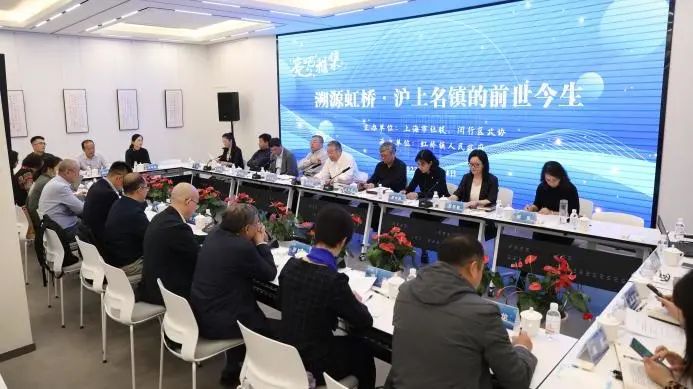Insights Exchange: The Past and Present of the Famous Hongqiao Town in Shanghai Convened
On October 24th, the Insights Exchange: Past and Present of the Famous Hongqiao Town in Shanghai was held at the Hongqiao Exhibition Hall of History and Culture, where experts and scholars from governments, enterprises, institutions, and universities held discussions on the history and future of Hongqiao Town in Shanghai.

Prof. Liu Shilin from the Institute of Urban Sciences of Shanghai Jiao Tong University suggested that Hongqiao Town should take into account of the overall Jiangnan Culture when it tries to sort out, study, and disseminate its profound cultural resources to create conditions for new changes in the image, connotation, and temperament of the town. He also recommended paying more attention to the history of Shanghai’s urban development when the town is defining its inheritance and uniqueness, so as to enhance its visibility. “Given that Hongqiao Town connects one of the most prosperous areas in China’s Yangtze River Delta, it should strive to obtain more development resources in a higher position, improve and optimize its functional form and develop itself as a landmark and an important vehicle of metropolitan Shanghai”.
Wang Jian, Research Fellow and Deputy Director of the Institute of International Sinology of the Shanghai Academy of Social Sciences delved into the origin and development of Hongqiao Town’s evolution and historical significance, such as the town’s genesis and rise as a hub for river transportation. From the middle and late Ming Dynasty on, Hongqiao emerged as a key center for the nationwide distribution of cotton textiles, reaching as far as Europe and America. Later, the influx of British and American cotton textiles into China led to a significant reduction in demand for the locally renowned “Nanking Cloth”. Coupled with the impacts of wartime disruptions, the textile industry in Hongqiao faced substantial challenges, resulting in a period of decline. This transformative process not only reflects the intricate relationships between Hongqiao Town’s national context with the external world, but also constitutes the overarching backdrop against which the town experienced prosperity and decline. At present, as the world once again intersects with Hongqiao, a new era unfolds, laden with fresh connotations. This necessitates a journey into the depths of history for a reexamination, preservation, and promotion of the rich heritage of Hongqiao Town.
Shi Zhangqiang, the Founder of Jonkon and Executive Committee Member of the Shanghai Federation of Industry and Commerce, believed that Hongqiao Town should optimize its urban planning and designing of “One Brand, Two Foundations, and Three Elements”, if it should keep on the right track of growth and outrun other towns. One brand refers to a core brand; two foundations emphasize the industrial base and the cultural genes; and the three elements stand for brand slogan, symbol, and culture.
Luo Xixian, a well-known Shanghai folk painter and picture-book painter, explained the creative concept behind Along the River in Hongqiao Town, discussing the possible artistic means of telling “Hongqiao's stories. He hoped this work of his had captured the vigorous Hongqiao Town in the early 1950s and brought the famous time-honored rainbow-illuminated Jiangnan Town to life on paper.
Zhao Wenlong, a collector and connoisseur of antique architecture and ancient furniture, is dedicated to unearthing the intrinsic values of his collectibles, so as to present the history of Hongqiao vividly. As a local resident of Hongqiao Town, he bears a profound affinity for his hometown and has amassed a notable collection of antique furniture from various stages of Hongqiao’s urbanization. He endeavors to present his historical narrative of Hongqiao Town most effectively through these tangible artifacts.

